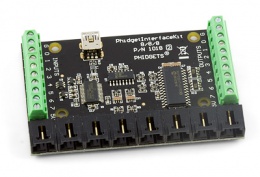About Phidgets Inc.
Quick: We want you to get your problem solved or your project finished as quickly as possible. The drivers are easy to install, and the Phidgets easy to set up. With a comprehensive API with code examples for nearly every device it's easy to write code and have something working in less than an hour. We always have products in stock and we ship fast so you won't have to wait long before you can put your plan into action.
Easy: Phidgets offers a robust API, making it easy to write a program in your favourite language and have Phidgets working right away. There's no propriety software that you have to download. Applications can be developed in over a dozen languages. Phidgets devices are also easy to set up. These devices are meant for people without an extensive electrical background, so you don’t need to mess around with circuits, just plug in a device and go!
Supportive: Plenty of guides, documentation, how to’s and examples are provided online to help you get your project going. Can’t find the answers? Phidget engineers are available by phone and email, and our Phorums are a great place to post questions to the community.
Cost Effective: You won’t be able to find higher quality sensors at the price of Phidgets. We focus on making well-engineered devices with affordable components, so you don’t have to break the bank to get something that works. Given Phidgets’ reliability, you won’t need to replace them anytime soon. Basically, you’re getting industrial quality devices at a hobbyist price.
How it all Started

The original idea for Phidgets came from Saul Greenberg, a computer science professor at the University of Calgary, who was researching Human-Computer Interfaces. His research involved the design and creation of customized computer interfaces that interact with the physical world- for example, a sensor that could detect when someone was working at a computer, causing a physical indicator like a light or a motor to activate. Computer science students do not typically have experience with designing and building electronics, so Saul would enlist electrical engineers to complete research projects by building the electronics and interfacing them with the computers. While this was a reasonable short-term solution, the projects were not self-sustaining. Once the project was complete, the engineer would move on with their studies and the project would inevitably fall into disarray.
To solve this problem, Saul decided to focus his designing and building efforts into specialized modules with a programming interface that would feel comfortable to any software developer. This solution had already been applied previously, particularly with graphical user interfaces (GUIs). The software behind a GUI is extremely complex, but each component (menus, sliders, buttons) is presented to the programmer as a simple, well-documented software object, sometimes called a "Widget". Saul's solution mirrored this concept with physical electronics- hiding complexity within a simple package. Any programmer could then build a customized system without having to worry about the minutiae of circuit design and low-level computer interfacing. Because of this similarity, these devices were called "Physical Widgets", or "Phidgets" for short.

Chester Fitchett started working on Phidgets as an undergrad in the Human-Computer Interface program. The first Phidgets were built by hand, with software written exclusively in Visual Basic 6 for Windows. Students from several universities used these early Phidgets in their academic projects. You can watch videos demonstrating some of these projects here. After university, Chester founded Phidgets Inc., believing that there was a market for Phidgets beyond academic research. The main challenge was adapting the Phidgets concept from something that was "good enough" for a research setting to a finished product that was reliable, user-friendly, and programmable using the most popular operating systems and programming languages.
Who uses Phidgets?
Today, Phidgets are bought by a wide variety of customers, each with a unique set of goals.
 |
Hobbyists use Phidgets to build fun projects in their spare time- for example, a sound system that loads different songs based on which RFID tag is placed on the surface of the coffee table. Businesses use Phidgets to automate company processes, or monitor company machinery. Researchers use Phidgets to aid in highly customized experiments- for example, a network of Spatial Sensors to monitor earthquake activity across a city. Entrepreneurs use Phidgets to prototype their product ideas. |
